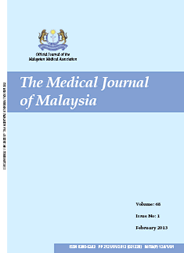MJM, Vol 70 Supplement 1 September 2015
Prevalence and psychosocial determinants of tobacco
use among adolescent female students in Jeddah, Saudi Arabia
*Department of Community Health, Faculty of Medicine and Health Sciences, Universiti Putra Malaysia, Serdang, Selangor, **Department of Counselor Education & Counseling Psychology, Faculty of Educational Studies, Universiti Putra Malaysia, ***Department of Psychiatry, Faculty of Medicine and Health Sciences, Universiti Putra Malaysia
ABSTRACT
Introduction: Tobacco use has been identified as one of the top ten avoidable risk factors that significantly contribute to disease, disability and mortality. The prevalence of tobacco use is increasing among youth, particularly in developing countries. The objective of this study was to determine psychosocial factors associated with tobacco use among 12-19 year-old Saudi female school students in Jeddah.
Methodology: A cross-sectional study using probability proportionate sampling was carried out in 40 female schools in Jeddah, Saudi Arabia between October 2012 and May 2013. Sample size (n= 5150) was calculated using the formula for hypothesis testing of two population proportions. Validated self-administered questionnaire was used to obtain the data. Analyses were conducted using SPSS version 22. Pearson’s chi-square test was used to determine the differences in the prevalence of tobacco use and psychosocial factors. Independent t-test was used to compare two mean scores. Multivariate logistic regression was used for determining predictors of tobacco use.
Results: The response rate was 98%. The overall mean age of the 5073 students was 15.5 years. The overall prevalence of ever tobacco use and current tobacco user was 44.3% and 18.3% respectively. Water pipe smoking was the main type of tobacco used by the respondents followed by cigarette smoking. The multivariate analysis showed that age, mother’s educational level, student’s monthly allowance, exposure to second hand smoking, stress, anxiety and self-esteem were significant predictors of ever and current tobacco use behaviours among the students.
Conclusion: The prevalence of tobacco use among 12-19 year-old Saudi female school students in Jeddah is high. There is an urgent need for tobacco use intervention programmes targeting female adolescents in Jeddah.
Keywords: Female adolescents, tobacco use, psychosocial, predictors.
